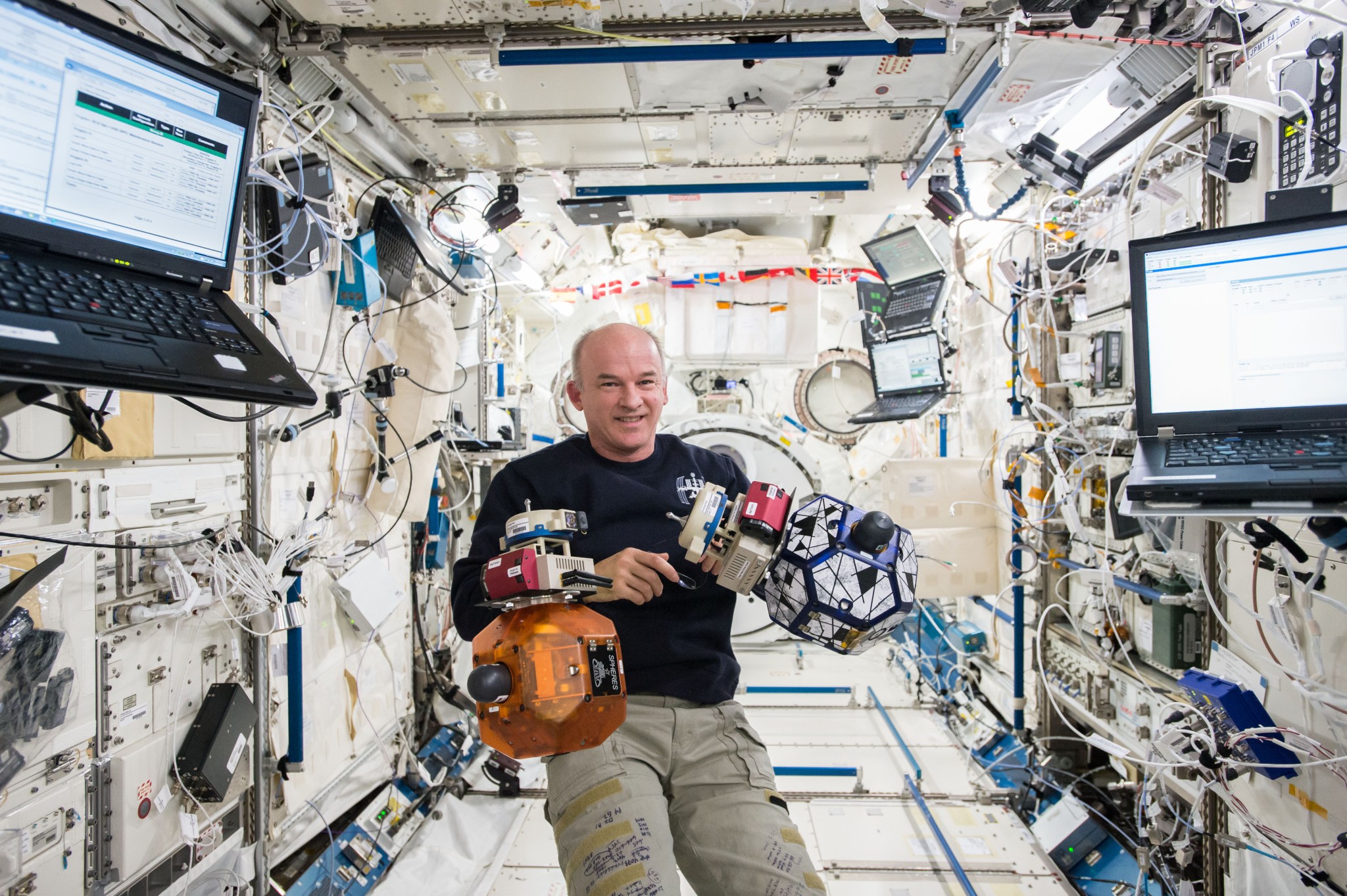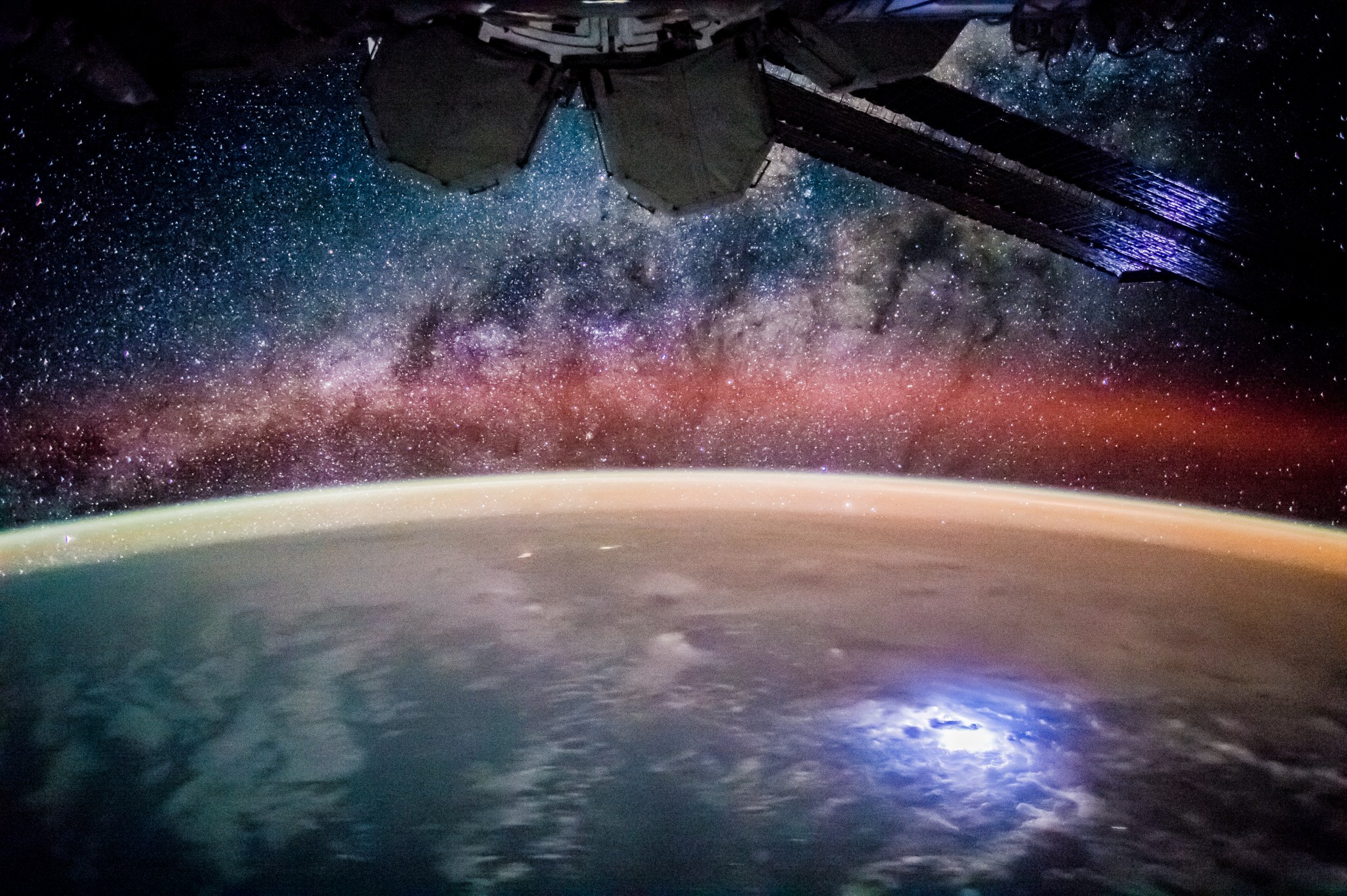In This Week’s Star
- NASA Astronaut Jeff Williams to Visit Marshall on Feb. 23
- NASA to Launch Sequel to Successful Lightning Study Mission
- NASA Acting Administrator Robert Lightfoot Addresses National Space Club
- New Experiments and Equipment Launch to Space Station
- Marshall Director Todd May Inducted into Alabama Engineering Hall of Fame
- High School Chefs Whip Up Something Special for NASA Astronauts
- Black History Month Panel Discusses ‘The Crisis in Black Education’
- This Week in NASA History: Discovery Launches for Final Time — Feb. 24, 2011
- Obituaries
NASA Astronaut Jeff Williams to Visit Marshall on Feb. 23
By Bill Hubscher
NASA astronaut Jeff Williams, who lived and worked six months last year on the International Space Station as a flight engineer and commander, will visit NASA’s Marshall Space Flight Center Feb. 23. He will share highlights from his fourth mission to space as part of the Expedition 47 and 48 crews.
During his stay on the station, Williams performed numerous science experiments including research into biology, biotechnology, and physical and Earth sciences. When he returned from orbit Sept. 6, he set a new U.S. record for total days spent in space at 534. Williams and NASA astronaut Kate Rubins helped prepare the station for the future arrival of U.S. commercial crew spacecraft when the two installed an International Docking Adapter during a spacewalk.
Selected for the NASA astronaut class of 1996, Williams has led many branches of the Astronaut Office, including a temporary assignment at Marshall supporting the test and evaluation of the space station’s Laboratory Module. His first three missions to space directly involved the construction of the orbiting laboratory.
Williams will present mission highlights and take questions from the Marshall workforce at 1:30 p.m. in Morris Auditorium, Building 4200. He will also participate in a Facebook Live event at 3:30 p.m. on Marshall’s Facebook page.
For more information about Williams, click here, or visit his Twitter page. Williams frequently posted to his account while in orbit.
Hubscher, an ASRC Federal/Analytical Services employee, supports the Office of Communications.
NASA to Launch Sequel to Successful Lightning Study Mission
A hit Hollywood film often leads to a sequel. Sometimes those movies do well, but rarely will they eclipse the original. Undaunted by those odds, NASA is set to reboot a successful study of Earth’s lightning from space — this time from the unique vantage point of the International Space Station.
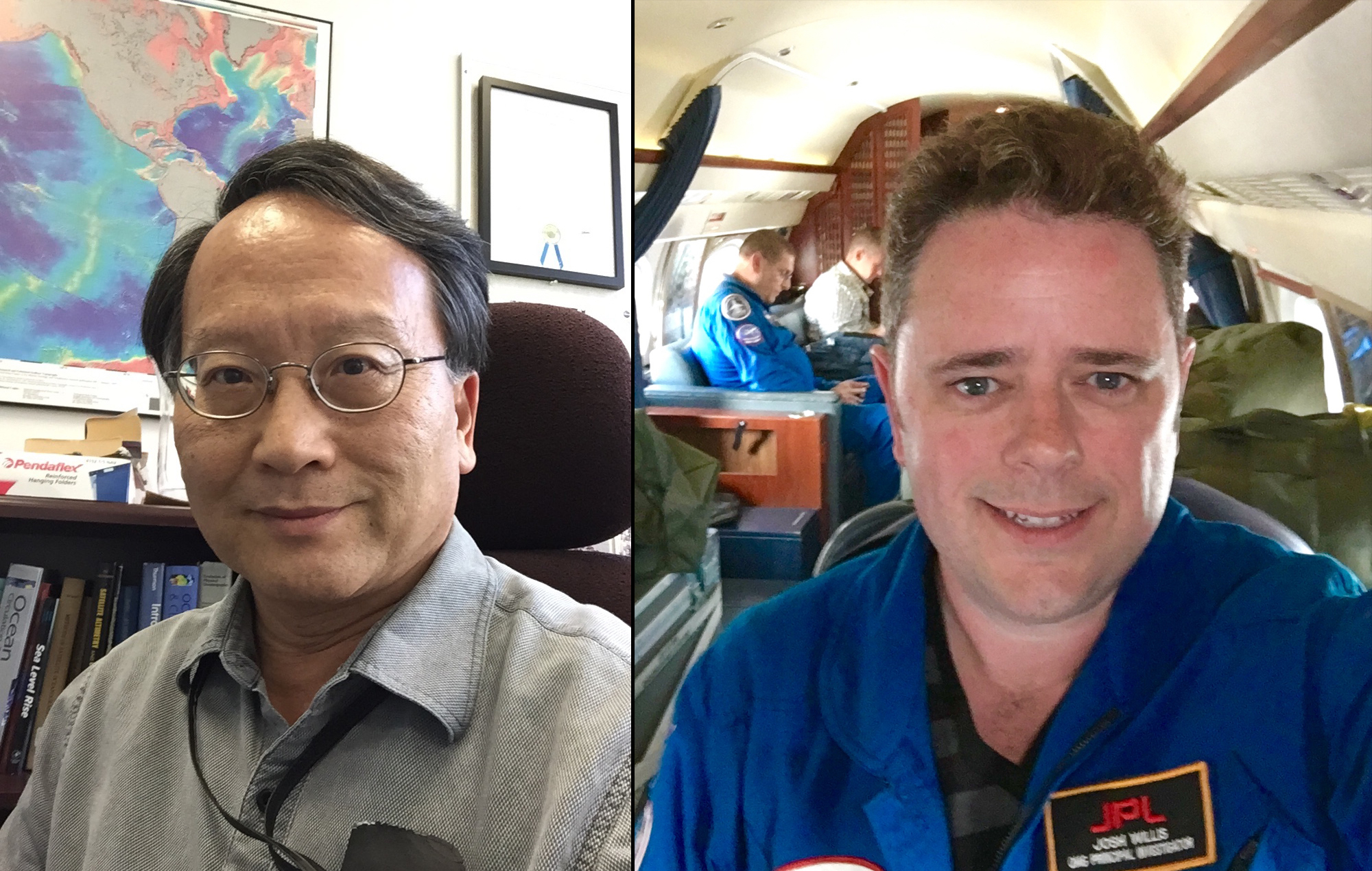
A team of Earth scientists at NASA’s Marshall Space Flight Center and the University of Alabama in Huntsville have high hopes for a follow-up mission for the agency’s Lightning Imaging Sensor first launched into space in the late 1990s. Now, an identical LIS — built as a back-up — is headed to the space station for a two-year mission to probe the mysteries of lightning and its connections to other atmospheric phenomena.
The LIS, which launched to the space station Feb. 19 on the 10th SpaceX cargo resupply mission, is a sophisticated lightning research instrument designed to measure the amount, rate and optical characteristics of lightning over Earth. Mounted externally on the station in an Earth-viewing position, the spare LIS will build on the foundation of space-based lightning observations begun by its predecessor.
The original LIS was launched in 1997 as part of the Tropical Rainfall Measuring Mission. LIS on TRMM was an outstanding success, delivering an impressive 17 years of lightning observations. But the TRMM satellite’s orbit only carried LIS over locations on Earth between 35 degrees north and 35 degrees south latitudes. So it gave lots of data for the tropics, but it could not observe far enough toward the poles to cover the more temperate zones, including more heavily populated areas away from the equator.
“The LIS used in this follow-on mission is an exact duplicate of the sensor used on TRMM,” said Richard Blakeslee, science lead for the LIS at Marshall. “But it will sample lightning over a wider geographical area.”
The orbiting laboratory’s higher inclination provides the opportunity to observe farther into the Northern and Southern hemispheres — all the area between 56 degrees north and 56 degrees south latitude.
Another advantage of using the space station for LIS observations is the capability to get lightning data downlinked in real-time and into the hands of scientists and other interested users. This data can be used for research or operational applications in data-sparse regions — over the oceans, for example — to provide situational awareness for weather forecasts, advisories and warnings. The real-time LIS data will be directly accessible to users around the world through a partnership with NASA’s Short Term Prediction Research and Transition Center, which is managed by Marshall.
LIS on the space station will also provide important cross-sensor calibrations, especially for the new Geostationary Lightning Mapper, an instrument based on LIS design heritage that is flying on the National Oceanic and Atmospheric Administration’s recently launched GOES-16 satellite. Cross-calibrating LIS data with other space-based lightning and weather instruments may create a longer lightning data record to improve our knowledge of severe weather formation and long-term changes in lightning distributions.
From the pioneering scientists who ushered in a new era of space-based lightning detection, this is one sequel that just may be scientific box-office gold.
NASA Acting Administrator Robert Lightfoot Addresses National Space Club
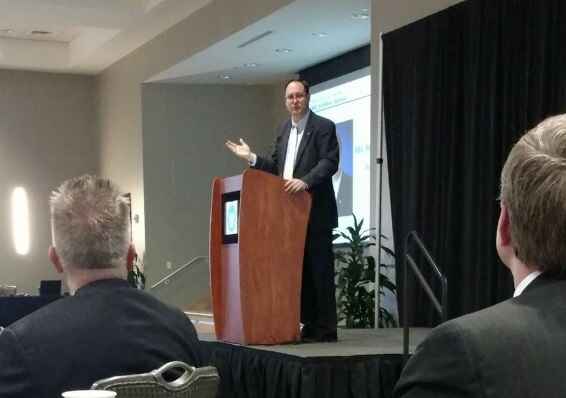
NASA Acting Administrator Robert Lightfoot addresses members of the National Space Club’s Huntsville chapter during a breakfast Feb. 17 at the Jackson Center. Lightfoot reported on the state of the agency and of NASA’s Marshall Space Flight Center, lauding the work of NASA and its partners on the Space Launch System, the most powerful rocket ever built. He also discussed the latest milestones on the International Space Station and numerous other science and exploration programs and flight missions. Founded in 1957 as the National Rocket Club, the non-profit National Space Club unites members of industry, government, academia and the private sector to support and share information about space exploration and astronautics and to promote American leadership in space. (NASA/MSFC/Kim Newton)
New Experiments and Equipment Launch to Space Station
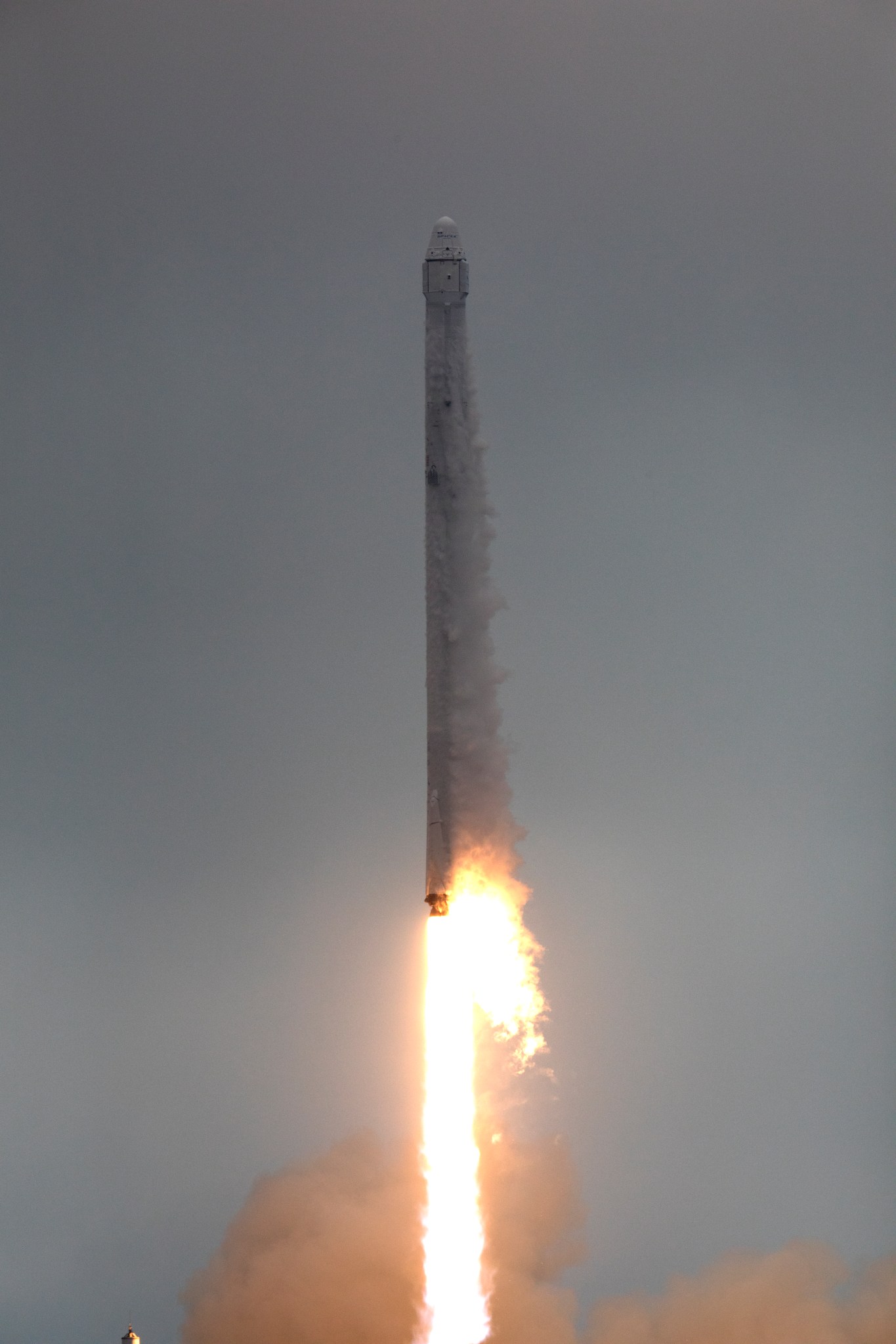
Major experiments looking into a range of scientific disciplines from human health to atmospheric conditions on Earth launched on the 10th resupply mission by SpaceX to the International Space Station from NASA’s Kennedy Space Center Feb. 19.
When the capsule arrives Feb. 23, astronauts Shane Kimbrough of NASA and Thomas Pesquet of the European Space Agency will use the space station’s robotic arm to capture SpaceX’s Dragon spacecraft, which is carrying about 5,500 pounds of research equipment, cargo and supplies.
Research materials flying inside Dragon’s pressurized area include a crystal growth experiment, an investigation into how bacteria become drug-resistant, a continuation of one of NASA’s longest-running Earth-observing programs and an instrument developed at NASA’s Marshall Space Flight Center to investigate lightning from space.
CASIS Protein Crystal Growth 5
The Microgravity Growth of Crystalline Monoclonal Antibodies for Pharmaceutical Applications, or CASIS PCG 5, investigation will crystallize a human monoclonal antibody, developed by Merck Research Labs in Kenilworth, New Jersey, that is currently undergoing clinical trials for the treatment of immunological disease. Growing the crystal in space allows it to develop more than it could on Earth where gravity causes crystals to collapse on themselves. Preserving these antibodies in crystals allows researchers a glimpse into how the biological molecules are arranged, which can provide new information about how they work in the body. So far, Earth-grown crystalline suspensions of monoclonal antibodies have proven to be too low-quality to fully model.
Nanobiosym Genes
Microgravity accelerates the growth of bacteria, making the space station an ideal environment to conduct a proof-of-concept investigation on the Gene-RADAR® device developed by Nanobiosym of Cambridge, Massachusetts. This device is able to accurately detect, in real time any disease that leaves a genetic fingerprint. The Nanobiosym Predictive Pathogen Mutation Study, or Nanobiosym Genes, will analyze two strains of bacterial mutations aboard the station, providing data that may be helpful in refining models of drug resistance and support the development of better medicines to counteract the resistant strains.
Stratospheric Aerosol and Gas Experiment III
The equipment aboard the Dragon includes a major instrument that will survey Earth’s upper atmosphere in a continuation of one of NASA’s longest-running Earth-observing programs. Called SAGE III, Stratospheric Aerosol and Gas Experiment, the instrument examines the levels of ozone, aerosols, nitrogen dioxide and water vapor in the stratosphere and troposphere high above Earth. It is the latest version of an experiment that began in 1979 and has created a multi-decade record of measurements. The 2,200-pound instrument will be connected to the outside of the station to make daily observations for several years.
Lightning Imagine Sensor
Marshall scientists contributed an instrument to investigate lightning from space. The Lightning Imaging Sensor will be mounted on the outside of the station to help understand lightning and its direct connection to weather patterns, lightning physics and atmospheric chemistry. See the NASA to Launch Sequel to Successful Lightning Study Mission story in this week’s Marshall Star for more information.
Dragon’s cargo will support dozens of the more than 250 science and research investigations during the station’s Expeditions 50 and 51. These investigations will be managed and controlled by the expert flight controllers at Marshall’s Payload Operations Integration Center – mission control for science on the space station which is crewed 24-hours-a-day and works closely with thousands of scientists around the world. The capsule is scheduled to depart the space station in late March, returning nearly 5,000 pounds of science, hardware and crew supplies.
Marshall Director Todd May Inducted into Alabama Engineering Hall of Fame
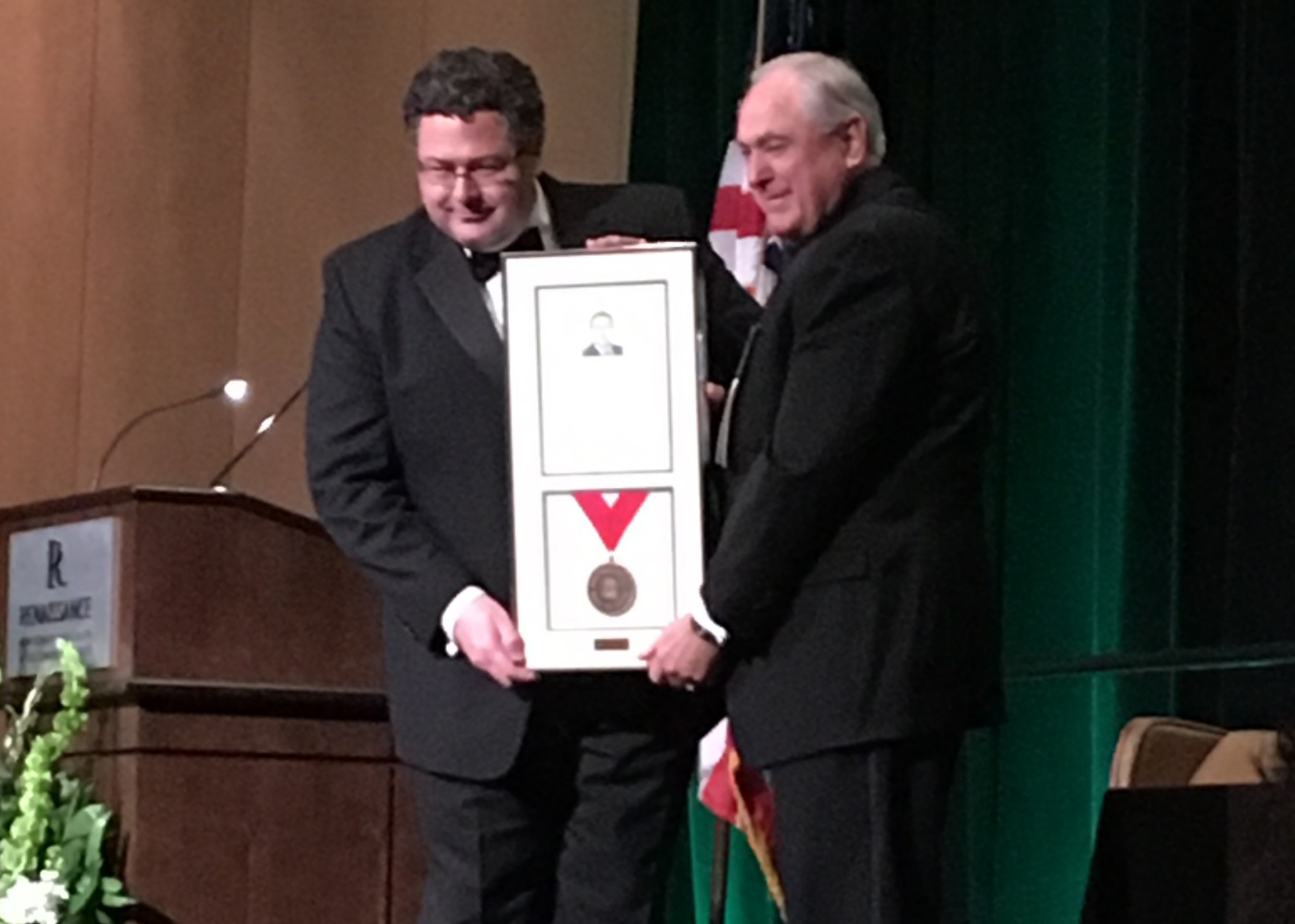
Todd May, left, director of NASA’s Marshall Space Flight Center, is inducted Feb. 17 into the State of Alabama Engineering Hall of Fame by Perry Hand, chairman of that organization’s board of directors. May and four Alabama business leaders — the Engineering Hall of Fame’s Class of 2017 — were honored during a ceremony in Montgomery, Alabama. The senior NASA official in Alabama, May was recognized for dedicating his nearly 30-year career to America’s space program and for his work on some of NASA’s most high-profile missions. May earned a bachelor’s degree in materials engineering from Auburn University in 1990. The Hall of Fame was founded in 1987 to honor the contributions and accomplishments of individuals, institutions and state projects that reflect positively on Alabama and those which continue to bring significant recognition to the state. The Hall of Fame is administratively managed by the University of Alabama’s College of Engineering and overseen by the engineering institutions at Auburn University, Alabama A&M University in Normal, the University of Alabama in Tuscaloosa, Tuskegee University, the University of Alabama at Birmingham, the University of Alabama in Huntsville and the University of South Alabama in Mobile. More than 175 individuals have been inducted into the Engineering Hall of Fame. For more information, click here. (NASA/MSFC)
High School Chefs Whip Up Something Special for NASA Astronauts
By Bill Hubscher
The U.S. Space & Rocket Center — the official visitor’s center for NASA’s Marshall Space Flight Center — hosted a prestigious cooking competition Feb. 16. The participants were not necessarily professional chefs, but the prize is one that any chef would be proud to have on a resume – his or her creation enjoyed by astronauts on the International Space Station.
Students representing 12 teams from six different schools created dessert options as part of the Culinary Challenge for the agency’s High Schools United with NASA to Create Hardware program, managed at NASA’s Johnson Space Center. As the name implies, HUNCH began working with schools across the country 14 years ago to build hardware for ground-based training systems at various NASA centers, encouraging technically minded students to pursue careers in the aerospace industry.
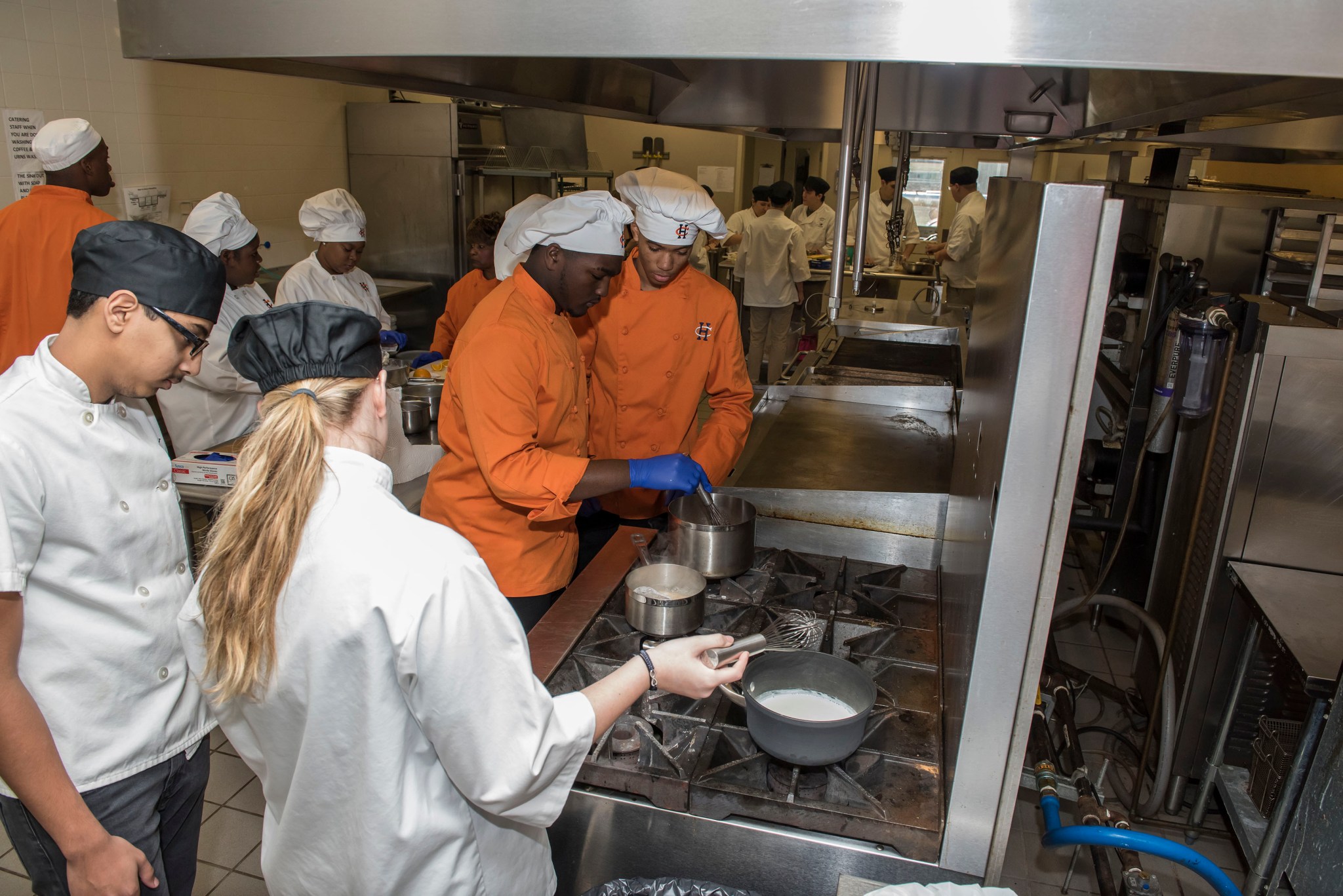
A few years ago, HUNCH program managers heard NASA astronauts were requesting some new options for meal time.
“We decided to expand our programs to include the culinary arts,” said Bob Zeek, HUNCH co-founder and program manager at Marshall. “Students use their imaginations to come up with a new dish for the crew while following the strict guidelines for the astronaut diet. The teams show their knowledge of nutrition while addressing the dietary needs of our station crew members.”
Previous competitions covered meat dishes and vegetable meals. This year, students were challenged to create a dessert option.
“When we first heard about this challenge, I thought it was a great idea,” said Paula Shute, culinary arts teacher at Charles Henderson High School in Troy, Alabama. “It was a fantastic educational experience for my students and a way to show off their culinary skills.”
“This is so exciting,” said Natasha Harge, a senior at Charles Henderson, as she put the finishing touches on an orange-cranberry shortbread cookie. “We’ve really invested in this, tweaking our recipe so it meets the requirements set by NASA. We had to reduce the fat and make it compact enough for launch. I just love to cook and the thought of astronauts enjoying something we made while they are in space is cool.”
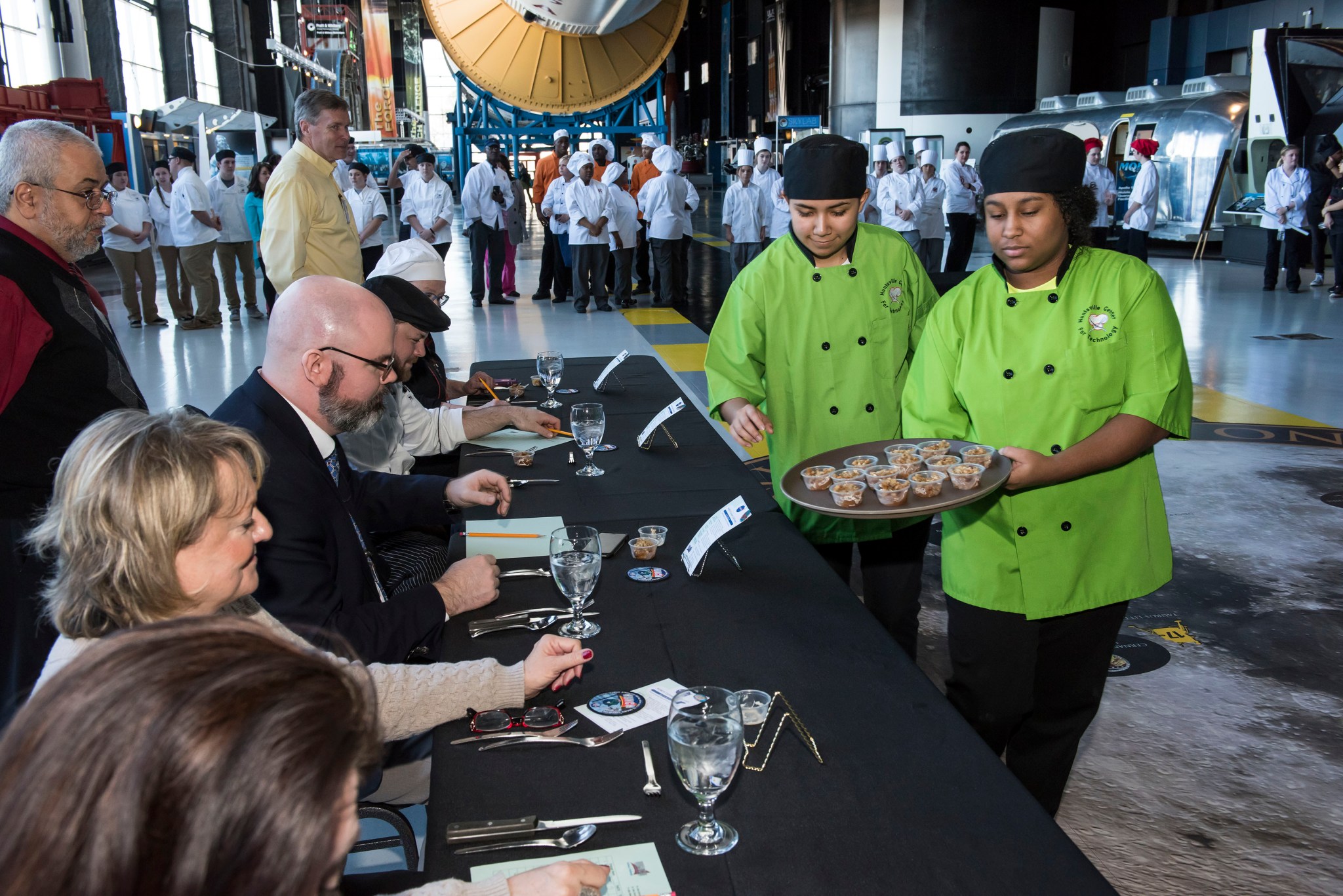
From the cookies to cinnamon-raisin brown rice pudding to peach-blueberry cobbler, there was a variety of options as expansive as the Alabama schools participating, which included Charles Henderson High School, Allen Thornton Career Technical Center in Killen, Bob Jones High School in Madison, Decatur High School, Huntsville Center for Technology and Hewitt-Trussville High School. Each school brought two teams to participate in the challenge.
“We tap into student creativity for this one,” said Alli Westover, program manager for this particular HUNCH challenge. “We hope students realize that their talents in culinary technology are just as important to the health and safety of astronauts.”
This was no easy challenge for the students. Besides following nutritional guidelines — which included low fat and low sugar — there was a consistency factor. The crew members can’t have cookie crumbs floating around the inside of the orbiting laboratory. And, of course, it had to taste good.
As part of the competition, students were required to research space food, looking at sizes and portions. Each had to write a research paper showing they understand basic nutrition and submit their recipe ideas to ensure it could be processed at NASA’s food laboratory at Johnson, where all the food on the space station is made and packaged before launch.
Preliminary rounds are still going on around the country. The top 10 teams from all the competitions will be invited to reproduce their recipes at the finals at the Johnson Space Center April 10. The selected winner will have his or her recipe recreated and processed for space — the proverbial icing on the cake.
Hubscher, an ASRC Federal/Analytical Services employee, supports the Office of Communications.
Black History Month Panel Discusses ‘The Crisis in Black Education’
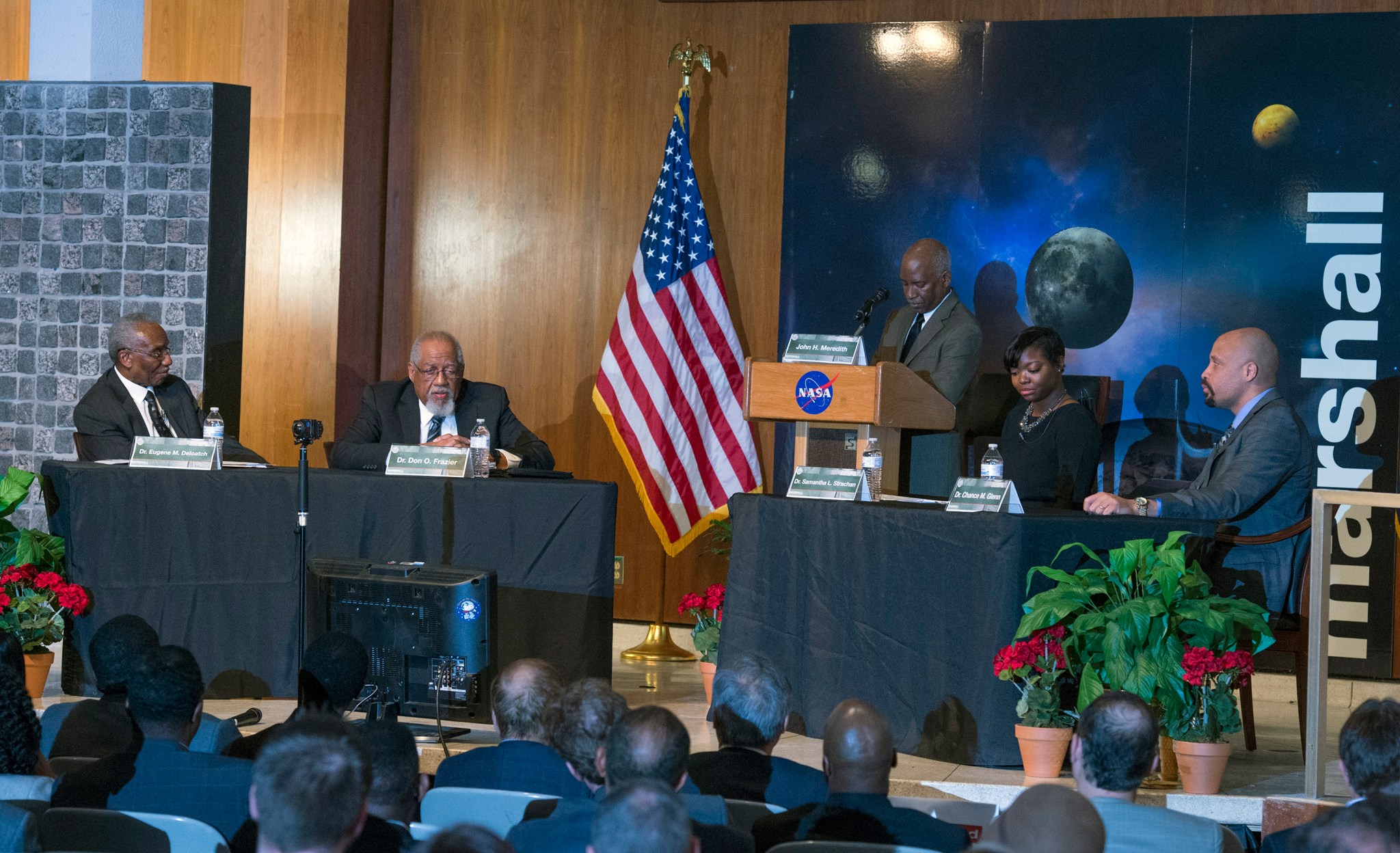
John Meredith, center, president and CEO of Meredith Advocacy, moderates a panel at NASA’s Marshall Space Flight Center Feb. 16 about “the Crisis in Black Education” — the 2017 theme for Black History Month, which was selected by the Association for the Study of African American Life and History. Meredith, the son of civil rights movement icon James Meredith, was joined on stage, from left, by Eugene Deloatch, dean emeritus at Morgan State University in Baltimore; Don Frazier, Marshall scientist emeritus; Samantha Strachan, assistant professor at Alabama A&M University in Normal; and Chance Glenn Sr., professor and dean of the engineering, technology and physical sciences at Alabama A&M. The panel discussion was followed by a presentation of the work of NASA interns from Alabama A&M paired with a sampling of ethnic food. The special emphasis month activities were sponsored by Marshall’s Office of Diversity and Equal Opportunity, which strives to promote diversity, equality and inclusion for all individuals, while providing a workplace that is free from discrimination, including harassment and retaliation. (NASA/MSFC/Emmett Given)
This Week in NASA History: Discovery Launches for Final Time — Feb. 24, 2011
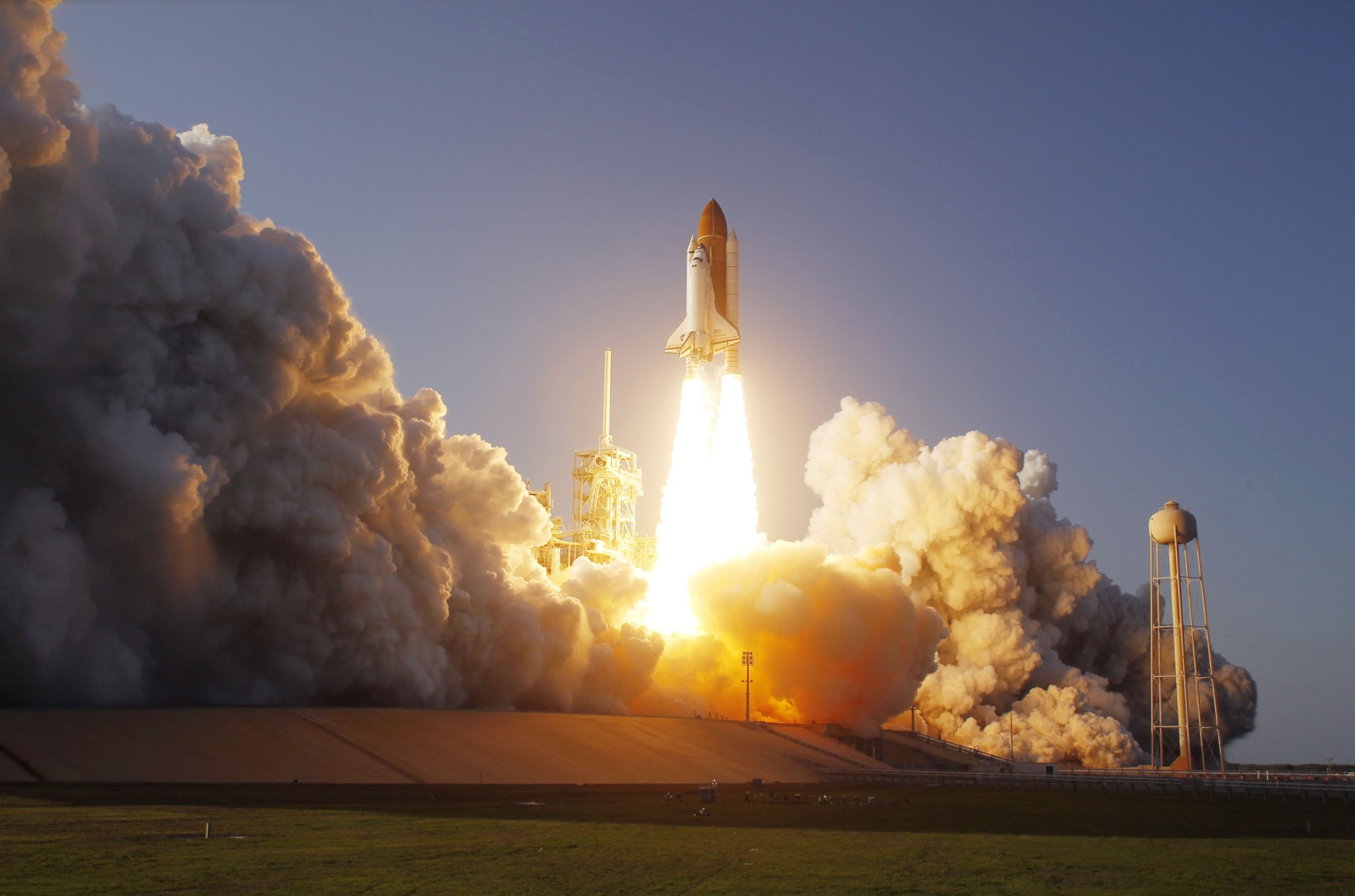
This week in 2011, space shuttle Discovery lifted-off from NASA’s Kennedy Space Center for its 39th and final mission. Discovery and its six-member crew delivered the Leonardo Multipurpose Logistics Module — packed with supplies, critical spare parts and Robonaut 2 — to the International Space Station. The first shuttle mission launched in April 1981, and for the next 30 years the program’s five spacecraft carried people into orbit repeatedly, launched, recovered and repaired satellites, conducted cutting-edge research and built the largest structure in space, the space station. Today, Marshall’s Payload Operations Integration Center serves as “science central” for the space station, working 24/7, 365 days a year in support of the orbiting laboratory’s scientific experiments. The NASA History Program is responsible for generating, disseminating, and preserving NASA’s remarkable history and providing a comprehensive understanding of the institutional, cultural, social, political, economic, technological, and scientific aspects of NASA’s activities in aeronautics and space. For more pictures like this one and to connect to NASA’s history, visit the Marshall History Program’s webpage. (NASA)
Obituaries
Dale J. Wasserman, 81, of Owens Cross Roads, Alabama, died Feb. 11. He retired from the Marshall Center in 1995 as an aerospace engineer. He is survived by his wife, Carol Phillippe Wasserman.
Barnes Beasley, 84, of Huntsville, died Feb. 12. He retired from the Marshall Center in 1989 as an aerospace engineer. He is survived by his wife, Jeweldine Beasley.
Martha G. Brock, 87, of Athens, Alabama, died Feb. 13. she retired from the Marshall Center in 1989 as a procurement clerk.



























